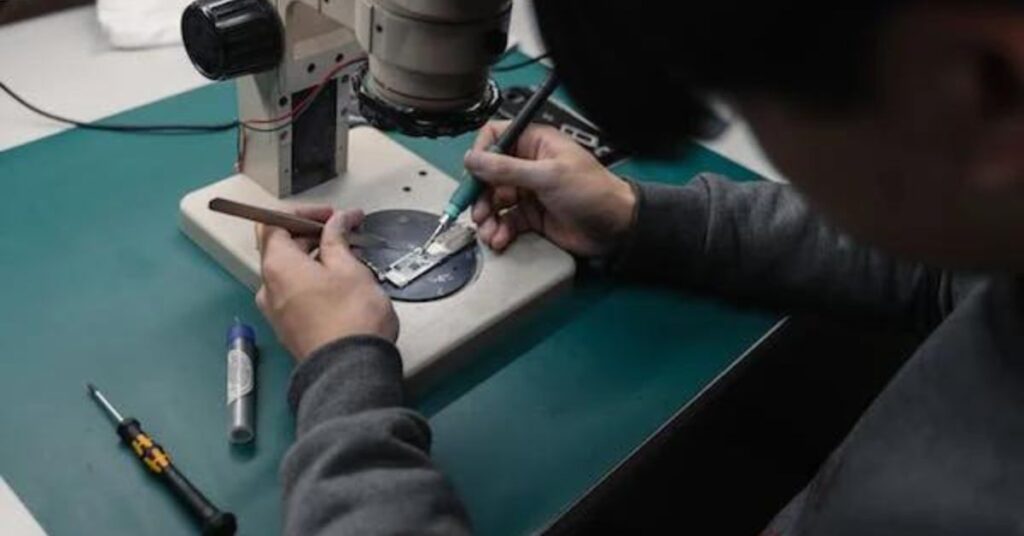Discovering your computer’s motherboard has suddenly failed can be incredibly frustrating. It’s a problem that often comes with a hefty price tag for a replacement. But before you jump to the conclusion that your motherboard is beyond repair, It’s important to think that fixing it is a practical solution.
Can a dead motherboard be repaired without breaking the bank? In this post, learn about the possibility of repairing dead motherboards, weighing the costs, benefits, and alternatives to help you make the best decision for your situation.
Table of Contents
How to Know if Your Motherboard is Dead?
When your computer starts acting up, it’s natural to suspect the motherboard as the culprit. But how can you tell if it’s truly dead? Here are some signs to look out for:
- No Power: If your computer refuses to turn on at all, it could indicate a motherboard issue. Check if other components receive power or if there are any signs of life from the system.
- No POST Beeps: During the Power-On Self Test (POST), your motherboard emits a series of beeps to indicate its status. If you don’t hear any beeps or encounter a sequence of continuous beeps, it might signal a motherboard problem.
- No Display: Even if your computer powers on, a blank screen or lack of display output could point to a motherboard issue. Ensure all cables are properly connected and try using a different monitor to rule out other causes.
- Frequent Crashes or Errors: If your system consistently crashes, freezes, or encounters errors shortly after booting, it could be due to a faulty motherboard.
- Burning Smell or Physical Damage: Visual inspection can sometimes reveal physical damage or burnt components on the motherboard, indicating a serious problem.
- Check Motherboard Standoffs: Ensure that the motherboard standoffs, which elevate the motherboard from the case, are properly installed and aligned. Misplaced standoffs can cause a short circuit and damage the motherboard.
- Inspect the Power Supply: A malfunctioning power supply can mimic symptoms of a dead motherboard. Test the power supply using a multimeter or try swapping it with a known working unit to rule out power-related issues.
- Verify Power Cables: Double-check all power cables connected to the motherboard, including the main ATX power connector and CPU power connector. Loose or improperly seated cables can prevent the motherboard from receiving adequate power.
Further reading: Can the motherboard be replaced?
Reasons Motherboard Repair May Be Possible

- Replacement of Faulty Components: Trained technicians can recognize and swap out integrated circuits or capacitors that are malfunctioning, thus bringing the motherboard back up and running.
- Soldering Fixes: Soldering techniques can be used to repair broken traces or loose solder joints on a motherboard, avoiding the need for a total replacement.
- Repairing Corrosion or Physical Damage: Using specialized repair techniques, it is sometimes possible to salvage a motherboard that would otherwise be unusable due to corrosion or physical damage.
- BIOS Updates: Occasionally, BIOS updates can fix software or firmware problems that are causing motherboard failure, revitalizing the hardware without the need for physical repairs.
Assessing if Motherboard Repair is Worthwhile
Determining whether repairing a malfunctioning motherboard is a prudent investment involves considering several key factors:
- Repair Cost vs. Replacement Cost: Compare the estimated cost of repairing the motherboard to the price of purchasing a new or refurbished replacement. Opting for repair may be more economical if the cost difference is significant.
- Age and Value of the Computer: Assess the age and overall value of the computer. Investing in motherboard repair for a relatively new or high-value system may be justified, whereas it might not be cost-effective for older or lower-value machines.
- Availability of Replacement Boards: Consider the availability of replacement motherboards compatible with your system. If suitable replacements are scarce or expensive, repairing the existing motherboard may be the more practical choice.
- Likelihood of Identifying the Cause of Failure: Evaluate the likelihood of accurately identifying the underlying cause of the motherboard failure. If the issue is straightforward and repairable, proceeding with repairs becomes more feasible.

Finding Technicians Capable of Motherboard-Level Repairs
Finding a skilled technician capable of performing intricate motherboard-level repairs is essential for ensuring a successful outcome. Here are some avenues you can explore:
- Independent Repair Shops: Seek out independent repair shops that specialize in electronics or computer repairs. These establishments often have technicians with the expertise to diagnose and repair motherboard issues at the component level.
- Specialized Electronics Repair Technicians: Look for technicians who specialize in electronics repair, particularly those with experience working on computer hardware. They may possess the technical know-how required to tackle complex motherboard repairs.
- Manufacturer-Authorized Service Centers: Consider contacting manufacturer-authorized service centers, especially if your computer is still under warranty. These centers employ technicians trained by the manufacturer and may offer motherboard repair services.
- Online Resources and Recommendations: Utilize online resources such as forums, community boards, and social media platforms to seek recommendations for reputable technicians or repair services specializing in motherboard-level repairs. Customer reviews and testimonials can also provide valuable insights into the quality of service offered.
Alternatives to Motherboard Repair
- Replace with a New or Used Motherboard: Replacing the old motherboard with a new or used one that is compatible with your system may be a good option if fixing it isn’t practical or economical. This lets you get functionality back without having to do major repairs.
- Upgrade to a Newer Motherboard/CPU: Take into consideration upgrading to a newer motherboard and CPU combination rather than fixing or replacing with a similar motherboard. This may prolong the life of your computer by enhancing performance and making it compatible with more recent technologies.
- Fix Other Components First: Investigate and fix any other components that might be causing the problem before deciding to replace or repair the motherboard. A broken CPU, a malfunctioning power supply, or faulty RAM can occasionally resemble the signs of a dead motherboard.
Can a Dead Motherboard Be Repaired?
Yes, a dead motherboard can usually be fixed, especially by knowledgeable specialists with experience fixing individual components. It is frequently possible to address problems like malfunctioning parts, loose solder joints, physical damage, or BIOS-related problems using repair methods.
The cost of repairs in comparison to replacement, the age and value of the computer, the availability of replacement boards, and the possibility of correctly determining the cause of failure all play a role in determining whether repair is a practical option or not. Even though motherboard repair may be an affordable option in some cases, it’s important to carefully consider the advantages and disadvantages before making a choice.
In the end, speaking with an experienced technician can assist you in figuring out the best course of action for your particular circumstance.
Pros and Cons of Motherboard Repair
Pros
- Cost-Effective Option: Repairing a motherboard can be more economical than purchasing a replacement, especially for newer or higher-value systems.
- Preserves Data and Settings: Repairing the existing motherboard allows you to retain your data, settings, and software configurations without the need for a complete system rebuild.
- Environmentally Friendly: Repairing rather than replacing reduces electronic waste and minimizes the environmental impact of disposing of a functional but faulty motherboard.
- Maintains System Compatibility: Repairing the original motherboard ensures compatibility with existing hardware components and peripherals, avoiding potential compatibility issues with a replacement board.
Cons
- Limited Warranty Coverage: Repaired motherboards may not come with the same warranty coverage as new or replacement boards, leaving you vulnerable to future issues.
- Risk of Future Failure: There’s a possibility that repaired components may fail again in the future, necessitating additional repairs or replacement down the line.
- Time and Expertise Required: Motherboard repair can be time-consuming and requires specialized knowledge and skills, potentially leading to longer downtimes and higher labor costs.
- Uncertainty of Outcome: Despite efforts to repair the motherboard, there’s no guarantee of success, and the repair may ultimately prove unsuccessful, requiring you to explore alternative solutions.
Frequently Asked Questions
Is it worth repairing a dead motherboard?
Whether repairing a dead motherboard is worth it depends on factors such as the cost of repairs versus replacement, the age and value of the computer, the availability of replacement boards, and the likelihood of accurately identifying the cause of failure. In some cases, repair may be more cost-effective than replacement, especially for newer or higher-value systems.
Can all motherboards be repaired?
While many motherboard issues can be repaired, not all are fixable, especially if the damage is extensive or beyond repair. It ultimately depends on the specific nature and severity of the problem, as well as the skill level of the technician performing the repairs.
How much does it cost to repair a motherboard?
The cost of repairing a motherboard can vary widely depending on factors such as the extent of the damage, the availability of replacement components, and the labor rates of the technician or repair service. It’s advisable to obtain quotes from multiple repair shops or technicians to compare costs before proceeding with repairs.
The average is 50$ to 300$.
